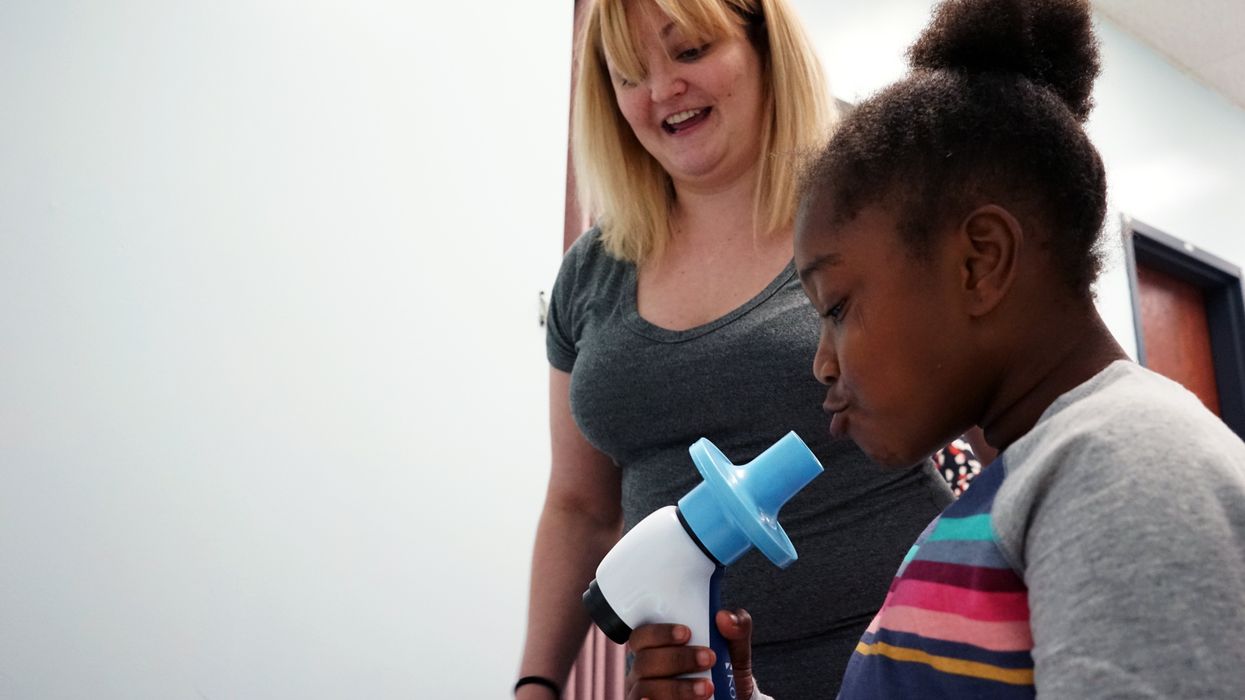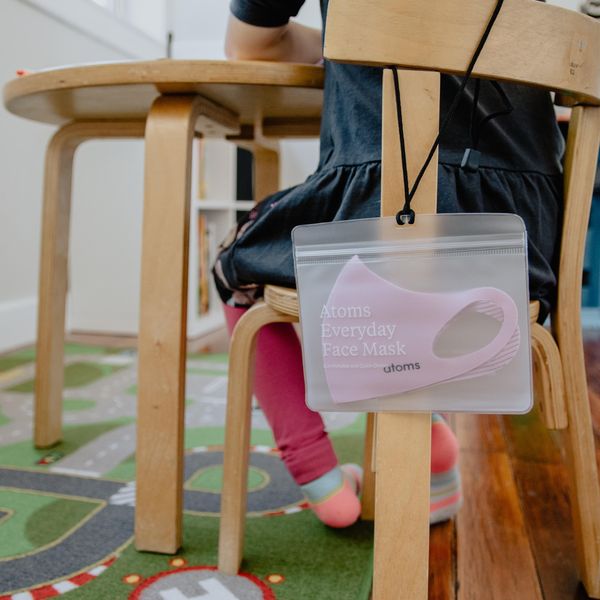Editor's note: This story is part of "Breathless," EHN's in-depth look at asthma in Pittsburgh and what can be done to help children breathe easier.
PITTSBURGH—When you arrive in Clairton, a small town 15 miles south of Pittsburgh, you're welcomed by a sign that reads, "Welcome to the city of Clairton, city of prayer."
As in much of Pittsburgh, there's a church of a different denomination every few blocks—some blocks even have two—but many of Clairton's are now shuttered, along with most of the town's businesses. A sign reading "DANGER: DO NOT ENTER" hangs askew in the storefront window of a long-abandoned hardware store, and the windows of the once-grand hotel that housed steel mill executives have been boarded up, as have the doors of the former Union Trust. Even the neighborhood Cricket Mobile store has been recently vacated.
Clairton has lost more than 66 percent of its population since 1950, and in the 1980s the Clairton School District consolidated all elementary, middle, and high schools into a single building. Behind the playground, plumes of smoke rise from the smokestacks of US Steel's Clairton Coke Works plant, the largest facility in the nation that still converts coal into coke, a material used in steel manufacturing.

When students of any age aren't feeling well, they all head to the same blue-walled school nurse's office, where, on a hot Monday morning in late May, seven-year-old Montaziyah Evans arrives to blow air into a spirometer that will measure her lung function and check for airflow obstruction.
"I'm gonna blow out all the candles on the cake," Montaziyah tells Erica Butler, the clinical research coordinator with the Pediatric Alliance who prepared the equipment. Montaziyah already removed her shoes to have her height and weight checked—she's grown two centimeters since her last visit.
"That's exactly right," Butler says, "You ready? One big breath in. Now blow as hard as you can...blow...blow. Good job."
Once a month, Butler comes to Clairton along with Dr. Deborah Gentile of the Division of Allergy, Asthma and Immunology at Pediatric Alliance as part of their initiative Caring for Asthma in our Region's Schoolchildren, or CARES*. Gentile launched the project after conducting a research study that revealed 18.4 percent of the children at Clairton Elementary have asthma—more than twice the national average. In total, her study examined more than 1,200 elementary school kids in eight of the county's most polluted school districts, and found 22.5 percent of the students had asthma. About 70 percent of the children were exposed to unhealthy levels of outdoor air pollution, according to World Health Organization standards.
For 16 percent of the children with the disease in Clairton, Gentile's study led to their first diagnosis, meaning they were living with the disease untreated.
"We didn't want to just come in and do our research and then leave these kids hanging," Dr. Gentile tells EHN. "We certainly need to clean up the air. But in the meantime, somebody also has to help these kids."
Gentile and her team are stepping in to help where the state and county have failed to do so—they're helping make up for a lack of reliable data or effective programs aimed at dealing with Pittsburgh's childhood asthma epidemic.
The CARES program enrolled 41 patients, ages 6-12, from six elementary schools for ongoing care through regular in-school asthma clinics, and is being treated as a pilot project that Gentile hopes to ultimately see expanded to every school in the county, then the state.
After Montaziyah's spirometry test, she also breathes into a machine that measures the levels of nitric oxide in her breath to determine how well controlled her asthma is. Then she sits down with Jennifer Padden Elliott, Gentile's partner for the project and Director of the Pediatrics Concentration at Duquesne University's School of Pharmacy. Elliott quizzes her about her treatment program, asking her to recite the names of her asthma medications, which ones are for control vs. rescue, and how often she's supposed to take each. She also asks her to demonstrate how to use both her controller and rescue inhalers, which Montaziyah does adeptly, miming pressing down on the cartridge and breathing in deep before holding her breath while counting to ten on her fingers.
Since their initial educational visits, Elliott has been quizzing the kids enrolled in the clinic each time she sees them and tracking their progress. The quiz is also given to parents and caregivers, usually over the phone. Their findings are still preliminary, but so far they've seen significant improvements in both control of the disease and knowledge about how to manage the disease in both parents and kids.
"Typically what we find is that over three months time, we're able to take a child from either having no or only partial knowledge of their asthma medication to having full knowledge," Elliott tells EHN.
Gentile uses a four-question screening process that was initially developed and validated by the Breathmobile program, which originated in Los Angeles. During Gentile's initial pilot project the participants' screening results were validated against their lung function testing by a statistician, who determined the survey was 85-90 percent effective at obtaining an accurate preliminary asthma diagnosis. In the CARES model, the students who are diagnosed by the survey then receive a full work-up by a clinician, complete with lung function testing at the in-school clinic and a visit with the pharmacist, who either brings their medications along or calls in a prescription to their pharmacy.
Gentile has contracted with a software developer to create a system that could be accessed for free by school nurses to conduct the screening as part of their annual health assessments for all students. She's currently operating on grant funding, but hopes that once she publishes her research on both asthma prevalence in the region and on the efficacy of the CARES project, county and state officials will step up to help kids like Montaziyah breathe easier.
"We see these school-based health clinics as an important way forward, but right now our state doesn't support this kind of model," Gentile says. "You need to get some support from the government to help fund something like this. In some states that happens. In Pennsylvania, it doesn't."
“A lot of disintegrated approaches”

Pharmacist Dr. Jennifer Elliott discusses asthma treatment with Ciara Cosby during an asthma screening at Clairton Elementary School in Clairton,PA. (Connor Mulvaney/EHN)
In 2016, the Pennsylvania Department of Health put out a strategic asthma plan for the state with goals through the year 2020 in partnership with the American Lung Association and the Pennsylvania Asthma Partnership.
One of the stated goals of the state asthma plan is to "improve environmental factors that cause/exacerbate asthma in Pennsylvania," and one of the strategies listed to support that goal is, "work with partners to improve and increase enforcement of indoor and outdoor air quality regulations and laws." But the plan doesn't include benchmarks or quantifiable goals toward that end, and doesn't include any mention of particulate matter pollution, despite evidence that pollution in Clairton is a primary asthma trigger, and that reducing it—even a little—goes a long way toward reducing asthma.
A recent study by the Allegheny County Health Department found that ER visits for asthma and chronic obstructive pulmonary disease (COPD) in the neighborhoods surrounding the former Shenango Coke Works Plant dropped nearly 38 percent the year after the facility shut down. Emission levels in Clairton are significantly higher than what was seen in Shenango, and according to another Allegheny County Health Department report, the Clairton plant had at least 6,700 air pollution violations over a three-year span between 2012 and 2015.
"Most asthma initiatives are effectively either individual behavioral change programs or population-level programs, some of which may have policy components," Polly Hoppin, a program director at the Lowell Center for Sustainable Production at the University of Massachusetts, tells EHN. Hoppin is a former Senior Advisor at the US Department of Health and Human Services and Environmental Protection Agency, and an expert on policy initiatives aimed at reducing the burden of asthma.
Related: ER visits for asthma dropped 38% the year after one of Pittsburgh's biggest polluters shut down
"There's a lot that can be helped by getting students on the right meds and getting them consistent care and monitoring. But asthma is a multifactorial disease, so there should be multifactorial approach if you want to reduce it at the population level. And one of the ways to do that is by reducing outdoor air pollution, in particular from major point sources like you have in Pittsburgh."
Allegheny County is uniquely poised to tackle its asthma problem on multiple levels at once—it's one of very few places in the nation to have a local air district that's overseen by a county health department.
In general, air quality is overseen by state environmental regulatory agencies, while in Allegheny County, the health department has been empowered by the state to interpret and administer the Clean Air Act. There are a handful of other places with local air districts, including all of California; Salt Lake City; and Louisville, Kentucky—but in most other localized districts, air quality is overseen by a separate, non-health department agency that's solely responsible for air quality.
The benefit of this unusual arrangement is that the Allegheny County Health Department has the power to set stricter air quality standards than in other parts of the state to address local concerns. One major shortfall is that a health department has a lot of other issues on its plate—everything from lead in the water and the opioid crisis to restaurant cleanliness, safe housing, and flu prevention—and doesn't necessarily have a direct mandate to protect and improve air quality in the same way an environmental regulatory agency does.
Another potential shortfall is that it's much easier for a local air district to become influenced by local politics, especially if major sources of emissions have political influence.

Clairton Elementary School in Clairton, PA. (Credit: Connor Mulvaney/EHN)
Pittsburgh environmental groups have long complained that the fines leveled by the health department against some of the region's largest emitters for Clean Air Act violations are so low that polluters are incentivized to treat them as a routine cost of doing business rather than cleaning up their operations. On more than one occasion, they've even announced intentions to sue the EPA unless they force the health department to enforce the Clean Air Act.
"The lack of fines that have been issued against violators of the Clean Air Act suggests to me that perhaps the board of health and health department are not able to use public health, from an air quality perspective, to address the continuing violations and lack of compliance," Matt Mehalik, the executive director of the Breathe Project clean air advocacy group, tells EHN.
The Allegheny County Health Department's director, Dr. Karen Hacker, says reducing pollution and lowering asthma rates are both priorities—though she emphasizes that asthma has many causes and triggers.
"There is no question that on a bad air quality day, you're going to see an increase in asthma attacks," Hacker tells EHN. "We are going to do everything we can as a Health Department to improve the air quality. There's no question there, and I would certainly hope that as that improves, we would see a diminution in new asthma cases and a reduction in emergency room visits for asthma."
The Allegheny County Health Department has also begun assembling an "asthma task force," which Hacker says includes 20 to 30 groups and individuals representing physicians, housing programs and insurance providers, including Gentile. As of now, the task force is still in the process of gathering data, which they're working to get from the region's major insurers. Some community organizers feel the task force is moving too slowly.
"More research and more data is always helpful," Jamin Bogi, policy and outreach coordinator at Pittsburgh's Group Against Smog and Pollution (GASP), tells EHN. "That said, we know we have high rates of asthma, and we know it can be caused or exacerbated by air pollution. We should not be delaying action to wait on yet another report when we already know we could help these kids by improving the air quality."
Dr. Sally Wenzel, the director of the Asthma Institute at University of Pittsburgh Medical Center, says initiatives aimed at asthma at both the county and state level in Pennsylvania have been inadequate to date. Wenzel was not asked to participate in the health department's asthma task force, despite being a leading expert on severe asthma.
"There have been some attempts at the local and state level to pull people together and work on the asthma problem, but I think it's still just a lot of disintegrated approaches," she says. "No one seems to be doing it in a very cohesive manner."
“You can’t write a prescription for closing down Clairton Coke Works.”

Smokestacks of US Steel's Clairton Coke Works in Clairton, PA. (Connor Mulvaney/EHN)
Hoppin described Pittsburgh's regulatory setup as "tricky."
"There really is a problem in the functioning of basic air quality regulation in Pittsburgh," she says, noting that in other places, best available technology has been employed at industrial sites in a way that is "not only technologically feasible, but economically as well."
Hoppin noted that Connecticut, Massachusetts, and California have especially robust asthma data collection and asthma action plans, and that Massachusetts has even begun implementing plans aimed at reducing the onset of asthma, rather than just treating patients who already have the disease.
"The challenge is that you never know in any individual case what combination of many factors may have contributed to the onset of asthma," she says. "But at the population level, you do know when you've identified multiple factors that contribute if you remove them or substantially reduce them, you'll see impact at the population level. That's the basic principle of environmental health."
Hoppin helped draft the Massachusetts state asthma plan, which includes specific benchmarks for reducing particulate matter pollution, along with measures aimed at reducing asthma triggers in schools and in homes, providing treatment within schools and communities and improving public education about the disease.
"After 10 years of work designed to deal with people who already had asthma, we had a number of clinicians saying, 'that's really important work, but it's not enough,'" Hoppin says. "We realized having single moms who are trying to hold onto a job while raising three kids who all have well-controlled asthma should not be our end goal. We need to go beyond that."
Those conversations resulted in a statewide coalition, the Massachusetts Asthma Action Partnership, which enlisted 50 organizations to sign on to 11 objectives and 73 actions as part of the state asthma plan over the course of five years. A mid-course assessment has indicated that many of their objectives are well underway.
Although many schools collect some form of asthma data, Hoppin wasn't aware of any cities or states that have implemented a mandatory asthma screening process like Gentile has proposed.
"But I do think it's a good idea," she says. "Especially when followed up with clinical care in the school environment like Dr. Gentile is doing."
She added, "You can't write a prescription for closing down Clairton Coke Works. But if as a clinician, Gentile is observing that air pollution seems to be a primary trigger for these kids, that should be an important part of the policy dialog moving forward."
Hoppin added that Pittsburgh and towns like Clairton are at a crossroads.
"It's also important to have a vision and a plan for economic development that is healthy, sustainable and climate-friendly," Hoppin says. "What would a future look like that provides for a just transition from aging industries to healthy jobs that manufacture and serve without landing Southwestern Pennsylvania among the top counties for asthma rates and cancer risk?"
Addressing the problem head-on

US Steel's Clairton Coke Works in Clairton, PA. (Connor Mulvaney/EHN)
Dr. Gentile and her team will treat any student referred by a parent, teacher, or school nurse through the CARES clinic, which means some of the students they see on a regular basis have mild asthma that's easily managed with occasional rescue inhaler use.
"But we've also encountered several [students] that have very severe asthma," Gentile says, "meaning that they're up every night with trouble, going to the emergency room, often missing school, not able to exercise and play."
Through the program, she says, they've managed to successfully help those students control their disease with the goal of minimizing missed school days and ensuring that they can exercise and play as much other kids—both of which have been linked to healthier and more successful long-term outcomes.
"We're addressing the problem head-on, but our long-term goals should definitely include prevention," Gentile says. "Again, asthma has many triggers, so clean air isn't the only thing, but it's certainly a big part, especially in places like Clairton. Changing that is going to require policy change, and to see that, we'll need to see members of these communities stand up and say they're not going to tolerate any more."
She adds, "The Allegheny County Health Department does appear to be on board to help. I think that's new, and not something we've necessarily seen with prior directorships, which is promising."
When Montaziyah Evans finishes reviewing her medications with Elliott, Gentile notices that she's scratching at a cluster of bumps on her arm. She asks the girl about them, and after learning that she's been waking up at night because she's so itchy, Gentile adds a prescription for atopic dermatitis cream to her asthma medications. She explains that many parents in the area lack reliable access to transportation, which can make it difficult to get to the doctor's office, so she tries to address as many of the kids' health issues as she can while they're in front of her.
Before she leaves for the day, Montaziyah is presented with a spread of colorful slap bracelets. She's allowed to pick two, and chooses one printed with smiley face emojis and one covered in rainbow hearts. She slaps one onto each forearm, then skates excitedly around the room in her socks before dropping into full split on the linoleum floor and throwing her arms in the air triumphantly, which elicits laughs and a small round of applause from the asthma clinic team.
"Alright," Dr. Gentile says, handing the girl her shoes, "good job, sweetie pie. Let's get you back to class now."
Editor's note: This article has been updated to clarify Dr. Hacker's statements on asthma and air pollution
*CARES and EHN receive support from the Heinz Endowments.


























